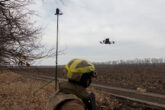February 03, 2016
Stop the Navy's carrier plan
When there is a crisis anywhere in the world, the president’s first question often is, “Where are the aircraft carriers?” The modern supercarrier lies at the very center of American national security strategy, and, at over a thousand feet in length and approaching nearly 100,000 tons in water displacement, it is a uniquely American weapon.
The U.S. Navy currently possesses 10 of these behemoths, and while China, Russia, Brazil, India and France each claim a single carrier in their naval inventory, none comes even close to matching the capabilities of an American flattop. When an iconic supercarrier comes within sight of a foreign shore, its citizens know that the Americans have arrived.
But the Navy’s current carrier plan would squander this military advantage — not by squeezing carriers out but by overbuilding them. Right now, the Navy plans to modernize its carrier program by launching a new wave of even larger and more expensive ships, starting with the USS Gerald Ford, which cost $15 billion to build — by far the most expensive vessel in naval history. This is a mistake: Because of changes in warfare and technology, in any future military entanglement with a foe like China, current carriers and their air wings will be almost useless and the next generation may fare even worse.
Read the full article at POLITICO.
More from CNAS
-
Defense / Transatlantic Security
When Defense Becomes Destruction: Austria-Hungary’s Mistake and Ukraine’s RiskThis article was originally posted on War on the Rocks. The southeastern Polish city of Przemyśl, with its elegant 19th century Habsburg-era train station, remains one of the ...
By Franz-Stefan Gady
-
Defense / Transatlantic Security
Ukraine’s Catch-22 MomentThis article was originally published in the Financial Times. In Joseph Heller’s wartime classic, Catch-22, the protagonist Yossarian seeks out the US army surgeon Doc Daneeka...
By Franz-Stefan Gady
-
CNAS Insights | Budgetary Own Goals Undermine “Speed and Volume”
On November 7, Secretary of Defense Pete Hegseth laid out a plan to overhaul the Department of Defense’s (DOD’s) acquisition system. Placing an emphasis on delivering new capa...
By Philip Sheers, Carlton Haelig & Stacie Pettyjohn
-
Drones: Who Is Making the New Weapons of War?
From Ukraine and Russia to Gaza and Sudan, drones have become a key weapon of war. Which companies are making them, and profiting from this rapidly expanding but controversial...
By Stacie Pettyjohn




